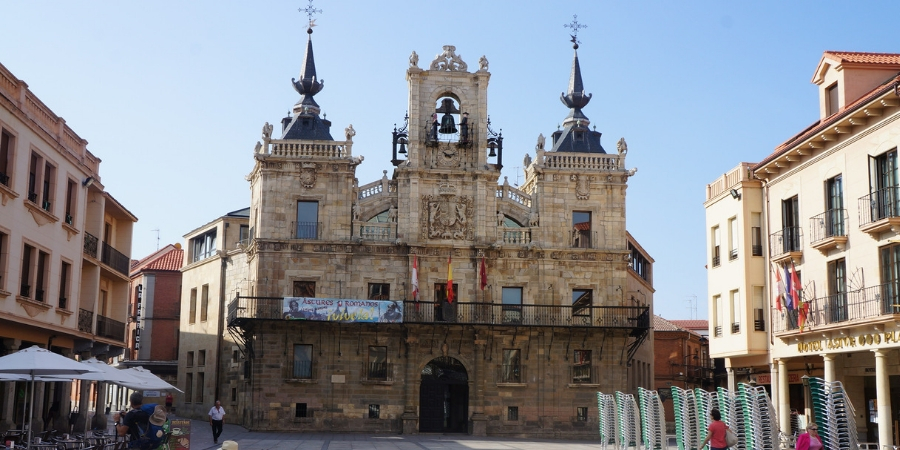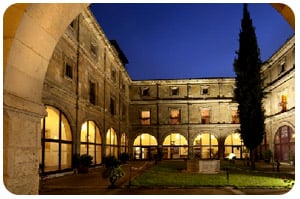 Hotel Real Colegiata San Isidoro
Hotel Real Colegiata San Isidoro
San Isidoro de León, on the French Way to Santiago de Compostela, is one of those special monuments and an amazing place to stay.
Located in the historic centre of León, San Isidoro is an impressive XI-century Romanic complex with a Basilica, a royal pantheon resting place of kings, a convent, a library and a museum. In the year 1063, King Fernando and Queen Sancha ordered the consecration of Saint Isidoro Basilica, next to the Royal Pantheon, and they ordered the remains of Saint Isidoro to be brought to León from Seville.
Since 2005, San Isidoro has also been open to the public as a restaurant and a unique hotel.

San Isidoro de León is an unforgettable stay on the Camino de Santiago. The hotel calls itself ‘Casa de Espiritualidad’, a spirituality home, and guests will certainly find a peaceful and restful space inside the doors of this amazing building complex. Stroll along the monument’s cloisters, admire the paintings, visit the vault, and explore the museum. Once you take in all the history and beauty, don’t forget to taste León’s traditional dishes and regional cuisine at the restaurant.
The Basílica de San Isidoro in Leon
The Basílica de San Isidoro (or Real Colegiata San Isidoro) is a Romanesque church located in the city of León in northwest Spain. It is a UNESCO World Heritage site and is considered one of Spain’s finest examples of Romanesque architecture. Here are some key facts about the Basílica de San Isidoro:
- History: The Basílica de San Isidoro was built in the 11th and 12th centuries and is named after St. Isidore of Seville, a 6th-century bishop and scholar. The church was originally built as a monastery and served as a royal pantheon for the kings of León. The church has undergone several renovations and additions over the centuries and has preserved many of its original Romanesque features.
- Architecture: The Basílica de San Isidoro is an example of the Mozarabic style of Romanesque architecture, which is characterized by the use of brick, stone, and sculpted decorations. The church has a basilica plan with a nave, two aisles, and an apse. The church is decorated with intricate stone carvings and frescoes and has a series of Romanesque portals.
- The Royal Pantheon: The Basílica de San Isidoro is home to the Royal Pantheon, which contains the tombs of several kings of León, including Alfonso V and Sancho III. The pantheon is located in the church’s apse and is decorated with frescoes and stone carvings. The pantheon also contains the tomb of Doña Urraca, the first queen of León, and the tombs of several bishops and abbots.
- The Museum of San Isidoro: The Basílica de San Isidoro is home to the Museum of San Isidoro, which contains a collection of art and artefacts related to the church’s history and city León. The museum includes a collection of Gothic and Romanesque art and several illuminated manuscripts and relics.
- The cloister: The Basílica de San Isidoro has a cloister, which is a covered walkway surrounding a courtyard. The cloister is decorated with Romanesque arches and stone carvings and is home to a small garden. The cloister was originally used as a place of contemplation and study by the monks who lived in the monastery, and it is now open to the public.
- The Basilica of San Isidoro today: The Basílica de San Isidoro is still an active church used for Mass and other religious ceremonies. It is also a popular tourist attraction, receiving thousands of visitors annually. The church is open to the public, and guided tours are available.
- The City of León: The city of León is located in the northwest of Spain, in the autonomous community of Castilla y León. It is the capital of the province of León and is known for its rich history and cultural heritage. The city is home to several other notable landmarks, such as the León Cathedral and the Monastery of San Marcos. The city is also known for its gastronomy and its wines, and it is a popular destination for food and wine lovers.
For more information or to book your own Camino adventure, please don’t hesitate to contact us.

 Hotel Real Colegiata San Isidoro
Hotel Real Colegiata San Isidoro